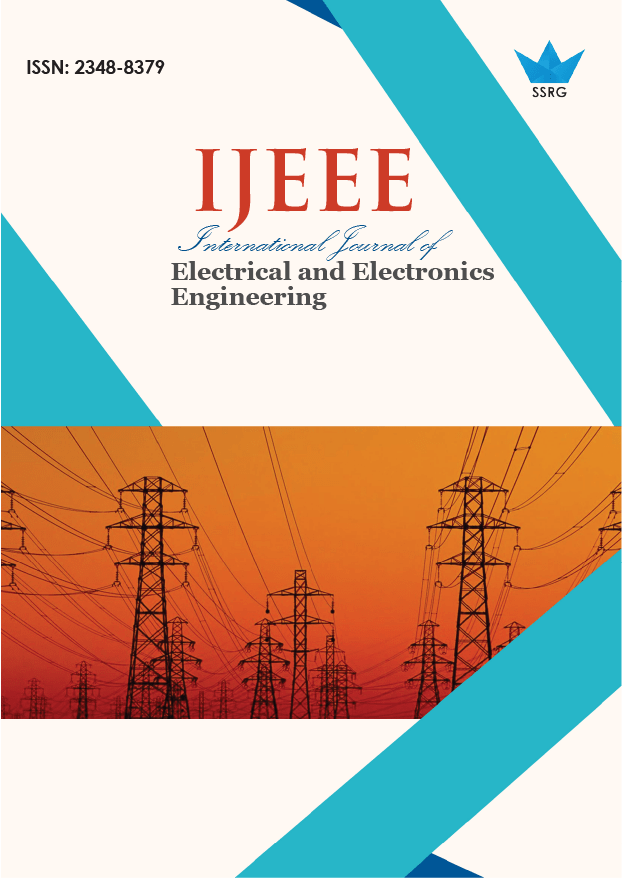The Design of Security Algorithm RPBB-24-1 in Multi-Way Path over the Distributed Ledger

| International Journal of Electrical and Electronics Engineering |
| © 2024 by SSRG - IJEEE Journal |
| Volume 11 Issue 4 |
| Year of Publication : 2024 |
| Authors : C. Bagath Basha, S. Rajaprakash, Nitisha Aggarwal, MD Riyazuddin, G. Sujatha, K. Karthik |
How to Cite?
C. Bagath Basha, S. Rajaprakash, Nitisha Aggarwal, MD Riyazuddin, G. Sujatha, K. Karthik, "The Design of Security Algorithm RPBB-24-1 in Multi-Way Path over the Distributed Ledger," SSRG International Journal of Electrical and Electronics Engineering, vol. 11, no. 4, pp. 36-44, 2024. Crossref, https://doi.org/10.14445/23488379/IJEEE-V11I4P105
Abstract:
Block Chain is one of the technologies that is gaining popularity in the modern world. The technology in question offers an exceptionally robust level of protection. Users do not have a lot of information about Block Chain, but its security is used to safeguard the data that is sent in several directions. This user continued to utilize the “ChaCha” and RBJ25 algorithms, which are considered to be compact and secure varieties. In this article, we present the new security mechanism that we have decided to call RPBB24-1. Two components make up the RPBB-24-1 approach, which are encryption and decryption. Five stages are involved in the encryption procedure. Assignment of the “Latin Alphabet cod” to PT is the first step in the procedure. Multiplying the number by itself four times using Equation (1) is the second step. Using encrypted data, the third procedure involves swapping the cell values, but the process begins with the 0th cell value from the most recent cell value. The fourth step involves dividing the prime key into the values of the matrix cells. Implementing the “ChaCha” algorithm in the matrix is the fifth step in the procedure. At long last, the ordinary text is transformed into encrypted text. Unlike the encryption procedure, the decryption approach works in the opposite direction. When compared to the approach that is currently in use, the suggested method offers a higher level of security.
Keywords:
Blockchain, ChaCha, Decryption, Encryption, Performance, RBJ25, RPBB-24-1.
References:
[1] Saurabh Singh, A.S.M. Sanwar Hosen, and Byungun Yoon, “Blockchain Security Attacks, Challenges, and Solutions for the Future Distributed IoT Network,” IEEE Access, vol. 9, pp. 13938-13959, 2021.
[CrossRef] [Google Scholar] [Publisher Link]
[2] Muhammad Nasir Mumtaz Bhutta et al., “A Survey on Blockchain Technology: Evolution, Architecture and Security,” IEEE Access, vol. 9, pp. 61048-61073, 2021.
[CrossRef] [Google Scholar] [Publisher Link]
[3] Mubashar Iqbal, and Raimundas Matulevičius, “Exploring Sybil and Double-Spending Risks in Blockchain Systems,” IEEE Access, vol. 9, pp. 76153-76177, 2021.
[CrossRef] [Google Scholar] [Publisher Link]
[4] Shailendra Rathore, Jong Hyuk Park, and Hangbae Chang, “Deep Learning and Blockchain-Empowered Security Framework for Intelligent 5G-Enabled IoT,” IEEE Access, vol. 9, pp. 90075-90083, 2021.
[CrossRef] [Google Scholar] [Publisher Link]
[5] Ranwa Al Mallah, David López, and Bilal Farooq, “Cyber-Security Risk Assessment Framework for Blockchains in Smart Mobility,” IEEE Open Journal of Intelligent Transportation Systems, vol. 2, pp. 294-311, 2021.
[CrossRef] [Google Scholar] [Publisher Link]
[6] Elham A. Shammar, Ammar T. Zahary, and Asma A. Al-Shargabi, “A Survey of IoT and Blockchain Integration: Security Perspective,” IEEE Access, vol. 9, pp. 156114-156150, 2021.
[CrossRef] [Google Scholar] [Publisher Link]
[7] Junyu Ren et al., “Task Offloading Strategy with Emergency Handling and Blockchain Security in SDN-Empowered and Fog-Assisted Healthcare IoT,” Tsinghua Science and Technology, vol. 27, no. 4, pp. 760-776, 2022.
[CrossRef] [Google Scholar] [Publisher Link]
[8] Antonio J. Cabrera-Gutiérrez et al., “Integration of Hardware Security Modules and Permissioned Blockchain in Industrial IoT Networks,” IEEE Access, vol. 10, pp. 114331-114345, 2022.
[CrossRef] [Google Scholar] [Publisher Link]
[9] Yunyeong Goh et al., “Secure Trust-Based Delegated Consensus for Blockchain Frameworks Using Deep Reinforcement Learning,” IEEE Access, vol. 10, pp. 118498-118511, 2022.
[CrossRef] [Google Scholar] [Publisher Link]
[10] P. Muralidhara Rao et al., “Blockchain Integration for IoT-Enabled V2X Communications: A Comprehensive Survey, Security Issues and Challenges,” IEEE Access, vol. 11, pp. 54476-54494, 2023.
[CrossRef] [Google Scholar] [Publisher Link]
[11] Garima Thakur et al., “An Effective Privacy-Preserving Blockchain-Assisted Security Protocol for Cloud-Based Digital Twin Environment,” IEEE Access, vol. 11, pp. 26877-26892, 2023.
[CrossRef] [Google Scholar] [Publisher Link]
[12] Leonardo Da Costa et al., “Sec-Health: A Blockchain-Based Protocol for Securing Health Records,” IEEE Access, vol. 11, pp. 16605- 16620, 2023.
[CrossRef] [Google Scholar] [Publisher Link]
[13] Lina Li et al., “A Secure, Reliable and Low-Cost Distributed Storage Scheme Based on Blockchain and IPFS for Firefighting IoT Data,” IEEE Access, vol. 11, pp. 97318-97330, 2023.
[CrossRef] [Google Scholar] [Publisher Link]

 10.14445/23488379/IJEEE-V11I4P105
10.14445/23488379/IJEEE-V11I4P105